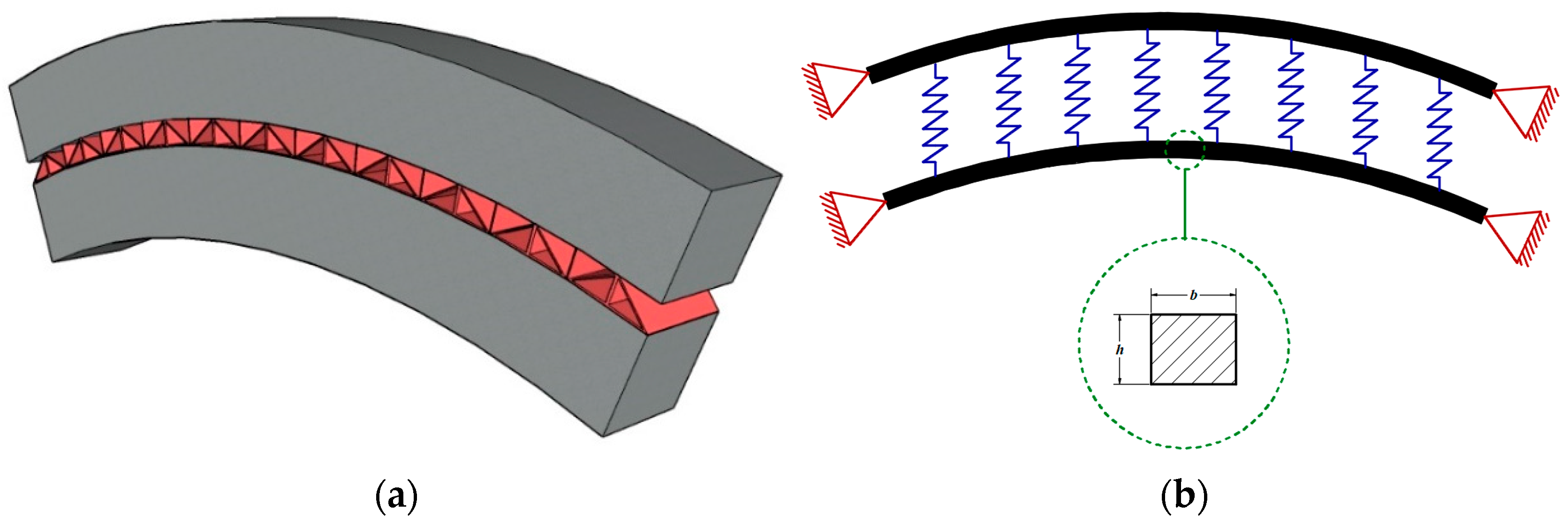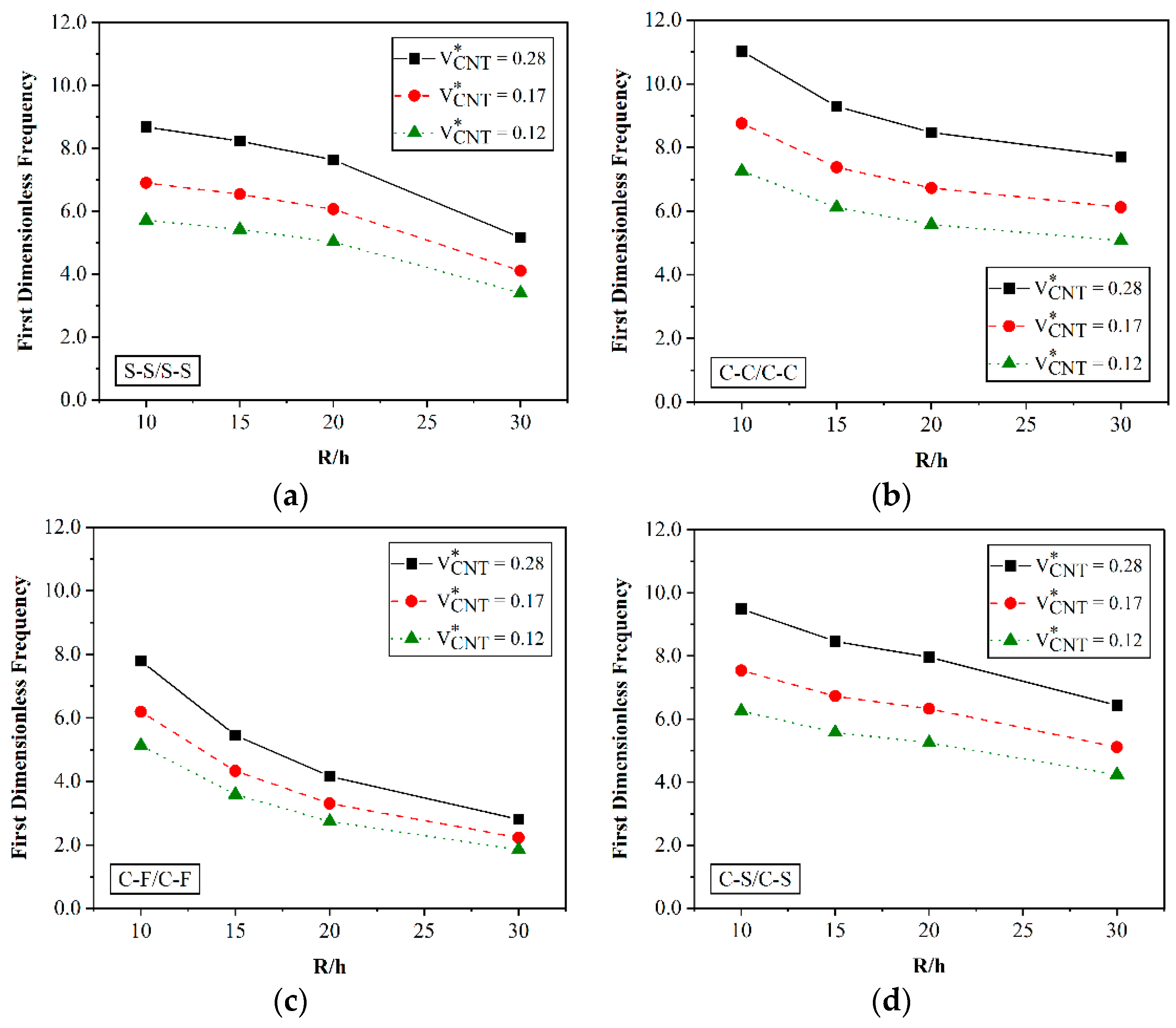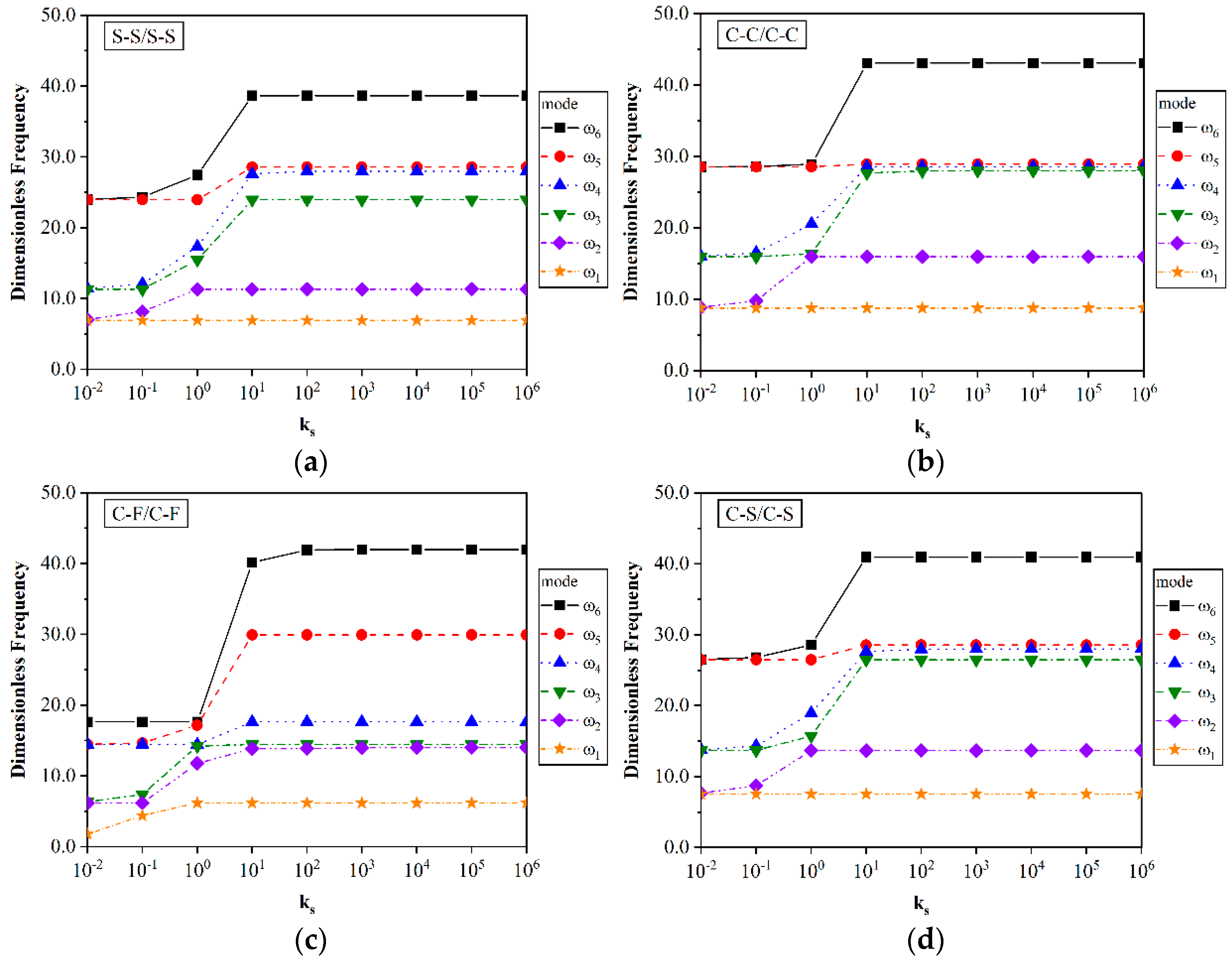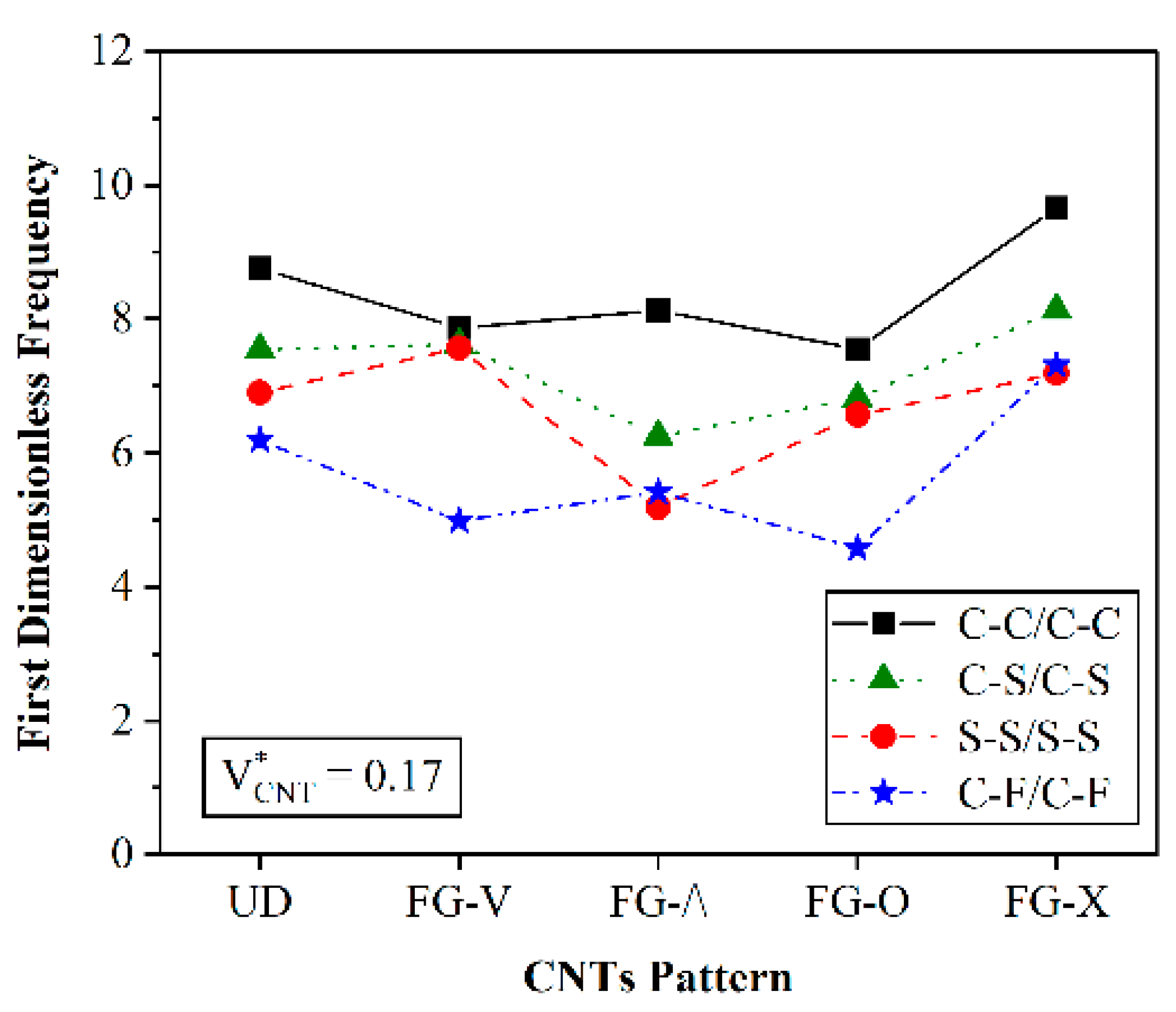1. Introduction
Among novel structural systems in civil engineering, coupled beams have increasingly been used in the last decades for highways, subgrades, and other facilities. This kind of system consists of beams with a straight or curved geometry, connected by an elastic layer, with a linear, non-linear, and plastic behavior. Despite the large amount of studies from the literature focusing on the structural behavior of single beams [
1,
2,
3,
4], some static and dynamic aspects for coupled beam systems have already been explored in the pioneering works by Seelig and Hoppmann [
5] and Dublin and Friedrich [
6], drawing increased attention from researchers in the recent years. These studies focused on static and dynamic behavior [
7,
8,
9], transverse vibration [
10], and forced vibration [
11], using viscously damped interlayer [
8,
12] among others. Among the most recent works, we can find studies focusing on the dynamic response of coupled curved beams, including both singly curved [
13,
14,
15,
16] and doubly curved systems [
17,
18,
19].
The earliest research on the vibrational behavior of beams resting on an elastic foundation was performed by Mathews [
20,
21] and Eisenberger [
22], involving one or two foundation parameters. Several researchers have recently been concerned with obtaining the natural frequencies of a curved beam with different geometries, loading, boundary conditions, and elastic foundations [
23,
24,
25,
26,
27,
28,
29,
30]. Although few studies have assessed the vibration of homogeneous coupled beams [
31,
32,
33,
34,
35,
36], research has focused on the effect of nanomaterials on the frequency behavior of these systems. Recently, Han et al. [
37] have presented an exact solution to define the dynamic characteristics of double-beam systems using an improved Wittrick–Williams algorithm. The vibrational behavior of a double-beam system connected to a viscoelastic layer was also studied [
38]. Additionally, numerical studies have been performed to determine the damping properties of a system using two beams [
39].
Advanced nanomaterials and their application have also motivated many studies to investigate their possible application in civil (structural and geotechnical) engineering, to create more efficient and sustainable materials [
40,
41]. Among them, single-layered hollow tubes are largely used as single-walled carbon nanotubes with diameter 0.4 to 2 mm [
42]. Functionally graded materials (FGMs) have been also proposed for their high performance, capacity, and low weight with an overall improvement of the mechanical behavior of the structure due to a non-uniform distribution of the material along different directions. Among them, functionally graded carbon nanotubes (FG-CNTs) represent the most common type of nanocomposite used in many structural members, such as beams, plates, and shells [
43,
44,
45,
46,
47,
48,
49,
50,
51]. Ong et al. [
52] investigated the dynamic response of double-beam systems in which CNTs were used as the reinforcing phase in the structure with different distribution patterns. In the further work [
53], the authors focused on the natural frequency of FG-CNT reinforced double beam systems in a thermal environment, where FG-CNTs stand for the reinforcing phase. The dynamic behavior of nanocomposite coupled beam systems is still being considered by different researchers. In such a context, many scientists have continued to investigate the dynamic responses of structures over the past few decades, accounting for different analytical solutions such as GDQ and DSC [
54,
55,
56,
57,
58]. The GDQ approach is a semi-analytical solution method with a fast convergence rate, as largely demonstrated in many applications of beams, plates, and shells [
59,
60,
61,
62,
63,
64,
65,
66,
67,
68,
69,
70,
71,
72] for different curved geometries, both in a static and dynamic sense. It is crucial to satisfy the boundary conditions accurately in order to obtain reliable and accurate solutions. It is worth mentioning that there is only one boundary condition that must be satisfied at each boundary point of a second-order differential equation describing a Timoshenko beam. For this reason, in a GDQ method, the discrete boundary conditions can be placed at the boundary points.
Starting with the literature overview, the vibrational behavior of curve coupled beams seems to be an interesting and relevant topic of structural engineering, possibly introducing a beneficial and efficient procedure for investigating their dynamic behavior, especially for nanomaterial reinforcements. This corresponds to the main purpose of the present work, which considers the effect of temperature on the frequency response of the selected systems, involving thermal-dependent mechanical properties for each phase. Notably, our novelty lies in the exploration of temperature-dependent (TD) mechanical properties, specifically focusing on poly methyl methacrylate (PMMA) strengthened with single-walled CNTs (SWCNTs). The unique aspect is the application of the basic rule of mixture to define equivalent mechanical properties for nanocomposites with TD characteristics. The equivalent mechanical properties of the composite material reinforced with CNTs are determined using a simple rule of mixture, where the governing equation of the beam is obtained by means of the Hamiltonian principle, which is then solved in discrete form based on the GDQ method. A validation study is performed against the reference literature to show the correctness and accuracy of the proposed procedure, where a systematic investigation examines the sensitivity of the frequency response to different input parameters, for both thermal-dependent and independent mechanical parameters of the composite material. Our analysis extends beyond the existing literature by comprehensively assessing the vibrational behavior of the structure under these varied conditions.
2. CNT Beams Material Properties
Let us consider a coupled curved CNT beam, with two curved beams connected with a layer of linear springs. The geometry of beams is described by a radius
R, length
L, central angle
θ, and transverse width and height,
b and
h, respectively, of the beam section. Different combinations of boundary conditions can be considered per beam, namely, clamped–clamped (C-C), clamped–simply supported (C-S), clamped–free (C-F) or simply–simply supported (S-S).
Figure 1 shows a simply supported (S-S/S-S) curved system with
made of a composite material reinforced with CNTs.
More specifically, the selected example considers a PMMA matrix and SWCNTs (10,10) as the reinforcement phase. Five types of reinforcement patterns are used here, including a uniform distribution of CNTs (UD-CNTs), as well as FG distributions of CNTs of type V, Λ, O, and X, as depicted in
Figure 2.
From an analytical standpoint, for example, a Λ−type variation of a function in the z direction can be defined as [
29]
In the particular case of CNTs volume fraction varying with a Λ distribution, it is
which reverts to a linear distribution throughout the thickness for
n = 1, namely
Based on the assumption of linear distribution, the mathematical definitions of all the selected CNT patterns along the
z direction are summarized in
Table 1.
Based on the role of mixture, we determine the equivalent mechanical properties of the reinforced beam as follows [
29]:
where
and
refer to the CNTs and matrix volume fraction, respectively;
,
and
indicate the normal and shear elasticity moduli of SWCNTs;
and
stand for the elasticity moduli of the matrix, respectively;
is a factor that considers the size-dependent material properties.
3. Theory and Formulation
The theoretical background of the selected in-plane vibration problem stems from the FSDT curved beam assumptions, while neglecting the deflections and rotations, and assuming a distribution of linear elastic normal springs at the interfaces. Thus, the kinematic field of the reference layer for each curved beam is defined as
where
and
define the displacement components of an arbitrary point in the longitudinal
and thickness
directions, respectively, whereas
and
refer to the displacement field of the neutral axis in the longitudinal
and thickness (
z) directions, respectively. For details about the geometrical definition of this system in its bottom and upper parts can be found in [
1]. The relation between the strain components of an arbitrary point and the reference neutral strain field is defined as
with
where
and
are normal and shear strain components,
and
are the normal and shear neutral strain components, and
represent the curvature of beams on the reference surface, with
. Based on the FDST assumptions for cylindrical panels, the kinematic relations are defined for each
th beam as
For an FG material, we consider the following constitutive relations:
where
is the normal stress,
is the shear stress, and
and
are elastic modulus and Poisson’s ratio of the beam, respectively. Therefore, forces and moments can be calculated by employing the integration of stresses in the
z-direction.
Forces and moments can be, thus, defined as
in which
In these equations,
,
and
are normal and shear force and moments and
is the shear factor which is equal to
. By using the Hamilton’s law and Gauss-Green theory, we obtain the following governing equations for the arched system (see more details in [
16]):
In these equations,
is used as a symbol to indicate the reference layer displacements for each beam, whereas the inertial terms
and
are obtained as follows:
5. Validation and Convergence Study
A numerical algorithm has been developed to compute the natural frequencies of coupled curved CNT beams, where the accuracy of results has been checked against frequency predictions in the literature [
13], based on a finite element method (FEM) for different boundary conditions. The geometry of the S-S curved beam is defined as R = 0.75 m, A = 4 m
2, I = 0.01 m
4, and R/h = 4, whereas the C-C example features the geometrical properties R = 0.6366 m, A = 1 m
2, I = 0.0016 m
4, and R/h = 6. The mechanical properties of the structure are set as E = 70 GPa, υ = 0.4166,
ρ = 2777 kg/m
3, and κ = 0.85, in line with Ref. [
13].
Table 2 summarizes the dimensionless frequency for the curved beam obtained in this research compared to results from Ref. [
13]. Based on the results, the frequencies computed with our approach are very close to predictions from Ref. [
13], thus confirming the accuracy of the proposed formulation.
At the same time, Sobhani and Masoodi [
16] applied the finite element approach to the vibration of coupled arched beams, connected elastically by a layer of springs at the interface, for different boundary conditions.
Table 3 validates our method for coupled arched beams with the results from Ref. [
16]. In this example, the geometry of the beams is defined as L
i = 10, R
1 = R
2 = 7.5, and h
1 = h
2 = b
1 = b
2 = 0.1. Material properties are E = 200 GPa, υ = 0.34,
ρ = 7850 kg/m
3, and κ = 0.87, and mid-layer stiffness is 16,000. Based on
Table 3, it is worth observing the very good correspondence among our results and the literature [
16] for all boundary conditions.
In accordance to Babaei [
30], we studied the free vibration of FG-CNTRC curved beams on nonlinear elastic foundations, and a convergence study was done to obtain the optimum value of grid points (N) in GDQM. Based on results, it was found that nine grid points is sufficient to ensure the accuracy of the frequency results for CNT beams.
Table 4 also indicates the first three dimensionless frequency
for the CNT curved beam, while comparing successfully them with our results, under the following assumptions for the properties of CNTs and size-dependent coefficient
Table 5 also shows the results in terms of first two dimensionless frequency of curved beams resting on the elastic foundation. The stiffness of the springs is equal to
. The geometry of the curved beam is defined as
and
.
6. Parametric Investigation
In this section, several examples have been solved to investigate the vibration properties of the system. For all examples, PMMA and SWCNTs (10,10) are used as matrix and reinforcement phase, respectively. More specifically, for CNTs we assume the following properties:
The PMMA instead features the following Young’s modulus, density and Poisson’s ratio:
The following efficiency parameters are set as
The stiffness of the interfacial springs is related to the mechanical and geometrical properties of the beams, as follows:
where
is the interfacial stiffness,
refers to the stiffness factor, and
can be determined as
where
and
v stand for the Young’s modulus and Poisson’s ratio of the pure PMMA matrix beam which was made by matrix, respectively. For such a case, the dimensionless frequency of the structure is determined as
where the inertial quantity
IBM of the beam is obtained as
.
Figure 3 shows the effect of the rational radius-to-height quantity of the beam on the first dimensionless frequency of the coupled curved beams. To this end, four values of 10, 15, 20, and 30 are considered for
, while setting the stiffness factor equal to 100. The geometrical properties of the beams are
, R
1 = R
2 = 10, and
. To investigate the effect of the CNT content, three different values of volume fraction are employed for CNTs, namely,
0.12, 0.17, and 0.28. A uniform distribution of CNTs is employed throughout the beam for comparative purposes, under the same assumption of CNT volume fraction for each arm of the specimen. The frequency response is obtained for a system with S-S/S-S, C-C/C-C, C-S/C-S, and C-F/C-F boundary conditions. The results show that the frequency of the system decreases for an increased value of
. This is true for all boundary conditions and all CNT volume fractions. Also, for this example, we investigate the effect of the CNT volume on the frequency response of the system. Based on the results in
Figure 3, a higher value of CNT volume fraction yields higher frequencies. For example, for a system with S-S/S-S boundary conditions and a fixed value of
, the first dimensionless frequency of the system increases from about six to nine by increasing
from 0.12 to 0.28.
By comparing the rate of reduction of frequencies for an increased R/h, we can deduce that the CNTs volume fraction does not affect the reduction rate. In addition, the reduction rate for S-S/S-S, C-C/C-C, and C-S/C-S boundary conditions is nonlinear, whereas it becomes approximately linear for a C-F/C-F example. Such effect of BCs can be observed from a comparative evaluation of the plots in
Figure 3. It can be also noticed that the frequency results associated with clamped boundary conditions are higher compared to other boundary conditions, in the following decreasing order: C-C/C-C > C-S/C-S > S-S/S-S > C-F/C-F.
Figure 4 shows the effect of the interfacial stiffness on the first six frequencies of the system, here defined by means of the coefficient
ABM which is obtained from the matrix properties. Nine different values are here considered as the stiffness factor, from 0.01 up to 10
6, whereas the CNTs volume fraction is assumed equal to 0.17 for a uniform distribution of CNTs. The geometry of beams is kept the same as in previous example, while assuming R/h is equal to 10. As already commented in the previous example, the higher values of frequencies are related to the system with C-C/C-C boundary conditions. For all boundary conditions, except C-F/C-F, the stiffness of the interfacial springs does not affect the first dimensionless frequency of system. Such sensitivity becomes more evident for higher modes of frequencies. The frequencies of the system increased for an increased interfacial stiffness up to a certain value of
, above which frequencies remain constant. From this figure, it seems that the effect of the interfacial stiffness on the frequency response has a direct relationship with boundary conditions and mode frequency.
Figure 5 shows the effect of the CNTs pattern on the first mode frequency of the system, with the same geometry discussed before, and for an interfacial stiffness equal to 100. The volume of CNTs is 0.17 and CNTs are assumed to be distributed linearly in the same pattern in both beams (UD). Based on this figure, the effect of the distribution pattern is related to the boundary condition of the system. In all BCs, except for S-S/S-S, the highest value of the first dimensionless frequency is associated with the FG-X pattern. The lowest values of frequencies are associated with the Λ distribution (for S-S/S-S and C-S/C-S boundary conditions), and to circular CNTs distribution (for C-C/C-C or C-F/C-F boundary conditions). Based on a comparative evaluation of the frequencies, we get the following sequencies of frequency for each selected boundary condition and different distribution patterns of the reinforcement phase:
For a C-C/C-C system: FG-X > UD > FG-Λ > FG-V > FG-O,
For a C-S/C-S system: FG-X > UD ≈ FG-V > FG-O > FG-Λ,
For a S-S/S-S system: FG-V > UD > FG-X > FG-O > FG-Λ,
For a C-F/C-F system: FG-X > UD > FG-Λ > FG-V> FG-O.
Furthermore, for V and O distribution patterns of CNTs, the boundary conditions do not affect the first frequency of the system. This statement is true for C-C/C-C, S-S/S-S, and C-S/C-S boundary conditions.
Table 6 represent the frequency values for different CNTs volume fractions in the system. In this example, the CNT volume fraction at the top beam remains constant at 0.12, whereas
at the bottom beam increases from 0.12 to 0.28. CNTs are uniformly distributed along the beams and the stiffness factor is equal to 100. The geometry of the beams is the same as in the previous example. Based on
Table 6, the frequencies of the system slightly increase by increasing the CNT volume in the bottom beam. It also seems that there are no differences in the system frequencies for an increased number of CNTs at the top beam and bottom beam. In other words, it is not important which beam contains a higher volume of CNTs to increase the frequency response of the system.
Table 7 shows the frequency response of the system when only the bottom beam is reinforced by CNTs, and the top beam is made totally by PMMA. The volume fraction in the bottom beam varies from zero to 0.28 with an X-type functional graduation, where the condition
= 0 corresponds to a pure matrix material. The geometrical properties of the beams are
, R
1 = R
2 = 10, R/h = 10, and
, with a stiffness factor equal to 100. For an increased volume fraction of CNTs from zero to 0.12 in the bottom beam, the frequencies of the system increase for all boundary conditions, while keeping constant for volume fractions from 0.12 to 0.28. This means that the volume of CNTs as reinforcement at the bottom beams can affect the frequencies of the system when the top beam remains unreinforced. Based on the same table, there is no difference in the frequency system when the top or bottom beam is reinforced with CNTs.
Figure 6 shows the effect of curvature on the first dimensionless frequencies of the system. The CNTs volume fraction is 0.17 and distributed uniformly along the beams, under the same geometrical assumptions R
1 = R
2 = 10, R/h = 10,
, and
equal to 100. In this example, six values of
are employed, where the frequencies of the system are computed for three different types of boundary condition. Note that by increasing
, the first frequency of the system decreases. For example, for C-C/C-C systems with a curvature factor of 15°, the frequency value is about thirty-nine and it tends to the unit value for
= 180°.
In this section, we investigate the thermal-dependent vibration of the system. There are several studies in which the effect of temperature variation on the structural behavior has been investigated [
79,
80]. Thus far, the mechanical properties of SWCNTs (10,10) and PMMA have been represented at room temperature (300 °K). For other environmental temperatures, we consider the following expressions to define the thermal-dependent mechanical properties for SWCNTs:
where
T and
T0 represent the environment and room temperatures, respectively. The thermal-dependent Young’s modulus for PMMA can be obtained at any temperature by employing the following equation:
The density and Poisson’s ratio in PMMA are also 1150 kg/m
3 and 0.34, respectively, in thermal environment.
Table 8 summarizes the variation of the mechanical properties for a SWCNT (10,10) and PMMA, with an overall monotonic decrease of all properties for an increased temperature.
It is worth observing that the mechanical properties of a pure PMMA matrix are more affected by temperature than the corresponding composite SWCNT (10,10). It is observed that the mechanical properties of PMMA and SWCNT decreases as the temperature increases. The following size-dependent parameters are here used in the rule of mixture to obtain the equivalent properties of beams in a thermal environment:
In this section, we ignore the possible effect of αΔT in the theoretical formulation, where we compute the dimensionless frequencies as
where
IBM and
ABM are computed at a room temperature (T = 300 °K).
Table 9 presents the first ten dimensionless frequencies of the system made of a pure PMMA matrix. Results show that an increased environmental temperature does not affect the frequency response of S-S/S-S and C-C/C-C structures.
Table 10 summarizes the first six frequencies of the system at different temperatures. Five values of temperature (300°, 400°, 600°, 800°, and 1000 °K) are assumed to evaluate the thermal sensitivity of the vibration response. The fraction volume of CNTs in both beams kept equal to 0.12 under the assumption of uniform distribution for the reinforcement phase. The geometry properties of the beam are still assumed as R
1 = R
2 = 10, R/h = 10, and
. The stiffness factor and the curvature angle are assumed equal to 100 and 45°, respectively. Despite the expected decrease in frequency for an increased environment temperature, we do not observe any meaningful variation in the vibration response of the selected system, since both curved beams are subjected to the similar temperature simultaneously, therefore, the frequency of the total system does not change.
In the last example, we study the vibration response of the structural system in thermal conditions, such that the temperature of one beam maintains constant to 300° and the temperature on the other beam varies from 300° to 1000°. In both beams, the CNT volume fraction is equal to 0.12 and a uniform distribution is assumed for the reinforcement phase. All geometrical properties of the beam, together with
ks and
θ, are assumed the same as in the previous example. In
Table 11, we summarize the frequency response of the system. Results show that by increasing the bottom beam temperature from 300 to 1000, the frequencies of the system slightly decrease. For example, for a S-S/S-S system, when T
bottom = 400°, the first frequency is equal to 5.6356 and reduces to 5.5142 when T
bottom = 1000°. An increased temperature at the top beam induces a variation in the structural behavior, when the temperature of the bottom beam is kept constant to 300 °K. Based on
Table 11, an increased temperature at the top beam yields an increased frequency response of the system, whereas the contrary occurs for an increased temperature at the bottom beam, which decreases the frequency response.















